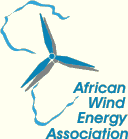Eritrea
If you have materials related to wind energy or are involved in the wind energy business in this country please contact the webmaster.
News
- 2005-09-22 Invitation for Expression of Interest Wind_Ene.pdf
Wind Energy Applications in Eritrea
A study for: UNDP/GEF
- Population of 3,3 million, one of the poorest countries in Africa
- Sources of energy:
66,3 % biomass (fuel-wood, dung, charcoal, agriresidue)
31,6 % oil products
2,1 % electricity (all from imported oil products) - 95 % of rural and 20 % of urban population do not have access to electricity
- Per capita electricity consumption: 54 kWh
- Regional grids, covering urban centres with total capacity of 156 MW (diesel thermal plants)
- and Diesel gen-sets in some villages
- Import of oil products for electricity generation impacts negatively on balance of payment
The government is preparing a legal and regulatory framework conducive to use of renewable energy.
There is experience with other renewable energies: solar (PV), biomass (energy efficient cooking stoves), etc.
- National wind mapping with 25 stations (GEF and SIDA)
- Significant exploitable wind resources in the southern coastal areas
- Favourable wind conditions in the middle and northern regions of Eritrea (mountains)
- Financing: Total of US$ 5,26 m
GEF: US$ 2,26 m
Government: US$ 2,0 m
SIDA & DANIDA: US$ m co-financing - Duration: January 2004 -2007
- Implementation: Department of Energy together with UNDP-GEF
- Installation and operation of a grid-connected small wind park (750
News
kW) - 8 off-grid stand-alone & wind-hybrid systems in rural villages
- Developing wind energy related capacities in public and private sector
- Reducing Eritrea’s energy-related CO2 emissions by promoting both on-grid and offgrid wind energy systems as a substitute for fossil fuel based energy generation
- Promoting socio-economic development and improving people’s livelihood by facilitating access and affordability to modern, clean energy services
The project focuses on removing barriers (institutional, technical, capacity, awareness) to the commercialization of wind by:
- demonstrating the viability of wind energy systems, and
- developing national capacity to plan, install and operate wind energy systems
Special Features:
- On- and off-grid combined in one project
- Small turbines (250 kW)
- Government commitment
This project has the potential to demonstrate that even in a small market within a poor country wind is a commercially viable alternative.
Wind park Assab
| Year of Installation | 2004 |
| No. of Turbines | 3 |
| Rated Power of Turbine in kW | 250 |
| Total installed Power in kW | 750 |
| Total annual electricity generation in MWh/y | 2,621.4 |
| Capacity Factor % | 44.3 |
| Annual fuel savings in 1,000 l/y | 681.6 |
| Annual CO2 savings in t/y | 1,700.5 |
| Total investment cost in 1,000 US$ | 1,027 |
| Total O&M cost in 1,000 US$/y | 40 |
| Average electricity generation cost in UScents/kWh | 5,4 |
| Average electricity generation cost in Nakfa/kWh | 0,73 |
source: UNDP, GEF
